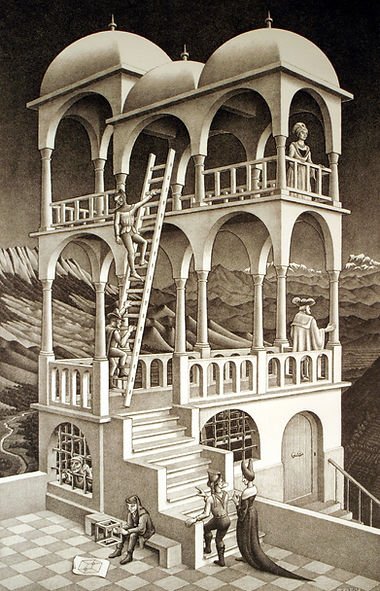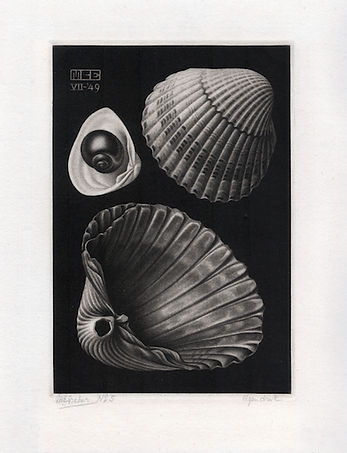ESCHER AND ITALY


M.C. Escher is best remembered for artwork that tickles the imagination. But even if he had stopped before creating tessellations and impossible buildings, his place in art history would have been secure by virtue of his images of cities and landscapes. This early work, neglected by the modern day public, was never forgotten by Escher. Elements of his years in Italy are woven into the creations we see every day on posters, calendars, and t-shirts.
The beauty and importance of Escher’s Italian period has been overshadowed by his later successes. Some critics and curators have been reluctant to accept Escher as a great artist. His work is occasionally dismissed as computer graphic novelty. Never mind that his work pre-dates computers, the Op Art movement, or the psychedelic ‘60s by decades. Ironically, the very innovation that he devoted the latter half of his life to was the very thing that took away from his well-deserved respect.
The cleanness of tessellating fish implied the work was easily created. True, a wood engraving of cartoon fish is technically easier to carve than a landscape, but conceptually, many more hours of planning are needed to devise tiled fish than the landscape. The difficulty of creating a tessellation is highlighted by the fact that the M.C. Escher himself only recorded 137 fully developed different tessellations in his notebooks and not all made the final cut to become graphic works.
It is an Escher-like paradox that if he had stayed in reality with portraits and landscapes he would likely be remembered as fondly as Rembrandt or Dürer in the art world. If the art world needs any proof that Escher is a legitimate master, they need to only look at the first half of his life. The Italian period not only stands by itself as an artistic accomplishment, but is the milieu for future works.
Historians group Escher’s life and work into four phases. The first is his early work, consisting of woodcuts and linocuts made as a student while in Haarlem. The artwork from this period is varied in theme. There are a number of portraits and even some drawings that hint at Cubism. Although he had been experimenting with linocuts, it was Samuel Jessurun de Mesquita, a graphics art teacher, that encouraged him to make this his field of study.
Examination of these prints demonstrates not only that he was learning to represent figures in black and white, but also that he developed the consummate techniques used to do so. One part of this process was to learn to think backwards. Every image carved into a woodblock for printing must be carved backwards, as though seen in a mirror. A closer look at Skull (ca. 1920) shows that he had not yet assimilated that lesson; the final printing shows a reversed “CE” of MCE.
The second phase is referred to as the Italian period. Escher visited Italy in 1923, and lived there from 1924 to 1935. During those years he traveled extensively and created a large portfolio of drawings, lithographs, and wood engravings of Italian landscapes, seascapes, and buildings. About 40% of his life’s work was created in those eleven years, including his largest lithographs. Escher’s life is reminiscent of the plot of an old martial arts movie. He starts off as a young man in his hometown. He leaves for a far away land. There he studies, practices, and works hard. When he returns home he is a master and can do things that people have never seen before. In this case, instead of learning karate he mastered wood engraving.
The woodcuts of Rome at night are a lesson well learned. In Trajan’s Column all lines radiate from the center, in Columnade all lines are diagonal, only their width varies, in another two night scenes everything is stippled, one woodcut is created of small crosses of various widths. Escher never did ‘single technique’ pieces after leaving Italy.
The technical achievements of this period were recognized by reviewers. R.W.P de Vries wrote that Escher’s “woodcuts have a dogmatic assurance”. Another critic wrote that “Escher is a patient, precise, cool draughtsman.” For example, the woodcut San Giovanni has a geometrical quality to it. It is not a picturesque representation of a beautiful church in Ravello; it is a calculated reproduction of arches and curves that is architecturally aesthetic. Inspection reveals that most of the print is merely series of parallel lines that when properly used give the appearance of curves. The rigorous quality of the woodcut divulges that Escher is of the right mind to cross over into the art of mathematics. The rest of his life will be devoted to works that take more patience and deliberation.
The third phase of Escher’s work extended for ten and to some extent to twenty years after he left Italy. During this period he focused less on representing the world as he saw it than on how it could be. One of the prints on the cusp of this transition is Dream. The subject is surreal, an oversized praying mantis standing on the chest of a sleeping bishop, but the background is Italy. The arches and the style of the engraving were modeled after the woodcut Porta Maria Dell’Ospidale. Soon after creating this woodcut Escher traveled to Spain. His trip to the Alhambra in 1936 influenced him profoundly and he soon devoted himself to the subject of tessellations. Although his work took a giant creative leap forward during this period, its importance was scarcely recognized in the art world.
The final period, from 1955 onward, is dubbed “Recognition and Success” by the M.C. Escher Foundation website. One could argue that commercial success should not be used when defining the phases of an artist’s works. We should focus on the themes. After 1939, Escher completed only one cityscape, his first mezzotint. He did not complete a single landscape or other cityscape the rest of his life; a stark contrast from the previous 15 years. From 1939 onward, Escher’s last thirty-three years, his work is riddled with impossible architecture and objects, complex tilings of animals, and artistic renderings of geometric and mathematical constructs—in other words, everything he became famous for. In fact, of his final 100 images, all the major pieces were fantastical except four. Three of the four involved reflection (Dewdrop, Puddle, and Rippled Surface), they might be viewed as studies on the geometry of reflections on different surfaces (round, flat, and rippled, respectively). The other major piece, his final mezzotint, was the still life of Seashells completed in 1949. Seashells could be considered a study of symmetries. In conclusion, even the artwork that appears ‘simple’ after 1939 was still a radical departure from serene subjects of his Italian period.
The third and fourth phases could be combined into one, which I will term the period of spatial relationships. This term is purposefully vague. The pieces that fit in this category have a variety of subjects; perspective, reflection, conflicts of dimension, approaches to infinity, illusion, and the shape of space (curved around a Möbius strip or spiraling into infinity like Print Gallery). It encompasses both the studies of tessellations, and also the buildings where the normal rules of architecture and geometry are tweaked to create something that cannot be built. Waterfall, for instance, looks plausible at any single segment of the water’s trough, but as a whole cannot be built. Works like Waterfall were novel and mesmerizing and increased Escher’s following dramatically.
Although the public cannot be condemned for loving and immortalizing the fun creations of these years, anyone with an interest in the artist should take a moment to look further back in time. Scrutiny of Escher’s famous works will show machinations and reprints of elements from earlier work. Escher never forgot his years in Italy when developing his imaginative masterpieces. The hints of Italy are what take his works from representations of mathematical constructs to beautiful works of art that would please the eye even without the “tricks.” And that is what made Escher famous: few people can name the discoverer of hyperbolic geometry, but Escher’s artistic representation of it (Circle Limit III) will forever remain in our collective consciousness.
The print Metamorphosis (1937) symbolizes Escher’s artistic transition from Italy to the imaginative world of the rest of his life. On the left is a coastal Italian city reminiscent of Atrani. It is done in the same style as his earlier Italian woodcuts and, in fact, was the subject of a nearly identical lithograph of Atrani. Unintentionally, Atrani represents his Italian past. As we move to the right, into the future, we see the world finally become more orderly into cubes. Escher’s future work will have an orderliness that surpasses all earlier works. The cubes transform into two-dimensional hexagons. This transformation from three to two dimensions occurs repeatedly over the following ten years (Drawing Hands, Two Doric Columns, and Reptiles). As we progress right the hexagons morph into a tessellation of Asian men. It is almost as if Escher had the foresight to ease his audience into the adventure he would take them on over the next thirty-five years.
When a year later he created Cycle (right), Escher’s transition was complete. The tessellating figures becoming part of the building are the focus of the print. To add to the fantasy, even the bars on the windows are impossible to construct. Any single bar could be made, but the entire unit could not be assembled unless each bar was divisible into smaller pieces. However, notice the background; although he left Italy a few years before making this print, the Italian landscape looks like part of Castrovalva. The left side of Metamorphosis and the top of Cycle also perform the function of adding quality to the simplicity of interlocked shapes. The tessellating tiles, while intriguing, appear to be children’s cut-outs. The Italian element of the prints adds artistic legitimacy. Escher leaves no doubt that the creator of the colored tilings is also a skilled graphic artist.
Jump forward twenty years to 1958. Belvedere must be in the same neighborhood as Cycle. The background is a similar valley in Abruzzi. The impossible crate the building is modeled after is seen in the hands of the seated figure on the lower left. Escher is almost teasing us. He was handed the wooden crate, but transformed it into a handsome building inhabited by Renaissance figures; once again adding quality to novelty. This artistic interpretation was repeated with the Penrose triangle to make Ascending and Descending (the monks attempt to climb a staircase that circles on itself), and the Circle Limit prints (see above) were modeled after a simple mathematic model. Note the prisoner: he is trapped behind the same impracticable bars seen in Cycle. Escher never forgot.






